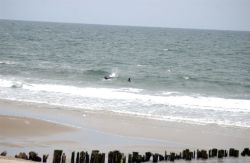Jamaica Bay and the Rockaways
Rockaway Beach
The origins of the name Rockaway Peninsula are closely related to the language of the Delaware and Chippewa Native Americans. Linguistic experts recognize both “Reckonwacky,” meaning “the place of our own people,” and “Reckanawahaha,” meaning “the place of laughing waters,” as the area’s indigenous names. Following the region’s European colonization during the seventeenth century, the present name was derived from these meanings. Other interpretations include “lekau,” meaning sand, and “lechauwaak,” for fork or branch. All interpretations reflect the historic and geographic traits of the peninsula.
The Canarsie Tribe, which originally inhabited the area, sold the mostly barren land to Captain Palmer, an Englishman, with a deed granted by then Governor Thomas Dongan in 1685. Disappointed with his purchase, Palmer sold the land in 1687 to a prominent iron master from Long Island, Richard Cornell, whose descendant, Ezra, founded Cornell University in 1865.
The Cornell family owned the land until 1808, when a partition suit divided the plot into 46 parcels, which were eventually sold to outsiders. The Rockaway Association, a group of wealthy New Yorkers, bought much of the property and began to build exclusive resorts in 1833. Within two years, James Remsen bought a large portion of the Peninsula. Remsen initiated a railroad project connecting the neighborhoods of Canarsie and East New York. The new railway was intended to greet steam ferries taking passengers to and from Rockaway. The Rockaway Peninsula remained a beachfront resort town, providing hotels, restaurants, and housing. During the 1890’s, a variety of amusement parks were built. In 1897, the Village of Rockaway Park was incorporated into New York City.
Improvements in transportation, under the direction of Parks Commissioner Robert Moses in the 1930’s, led to the growth of Rockaway. The completion of two bridges, the Marine Parkway Bridge in 1937 and the Cross Bay Bridge in 1939, connected Rockaway to mainland Queens and Brooklyn. Innovations in railroad service and the development of the elevated subway allowed popular access to the peninsula. Subway access stimulated Rockaway’s transition from a vacation area to neighborhoods with permanent residents.
Parks acquired Rockaway Beach, along with Coney Island, in Brooklyn and South Beach Staten Island from the city by charter in 1938. This section of beach extends from Beach 126th Street to Beach 149th Street and is part of the seven miles of city-owned beaches in Rockaway. Rockaway Beach extends through the communities of Belle Harbor and Neponsit. To the west is Jacob Riis Park, a federal beach and recreation area. Once part of Rockaway Beach, this area was transferred to the National Parks Service in 1974. Lifeguards are stationed on along the beach from Memorial Day through Labor Day. During the summer months, swimmers, walkers, and runners all use the beach. Each year local volunteers organize a beach-and-dunes clean up.
Check out your park's Vital Signs
Clean & Safe
Green & Resilient
Empowered & Engaged Users
Share your feedback or learn more about how this park is part of a
Vital Park System

Know Before You Go
Ecology Park is only open at certain times of year when Parks staff are present in order to protect this unique landscape. Want to visit? Check out our Stewardship Projects page for restoration, planting, and educational events.



